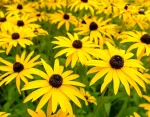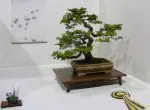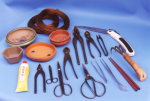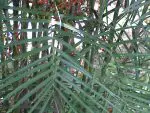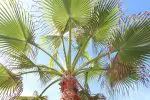This post contains affiliate links. If you buy something from one of our links we may earn a commission. Thanks
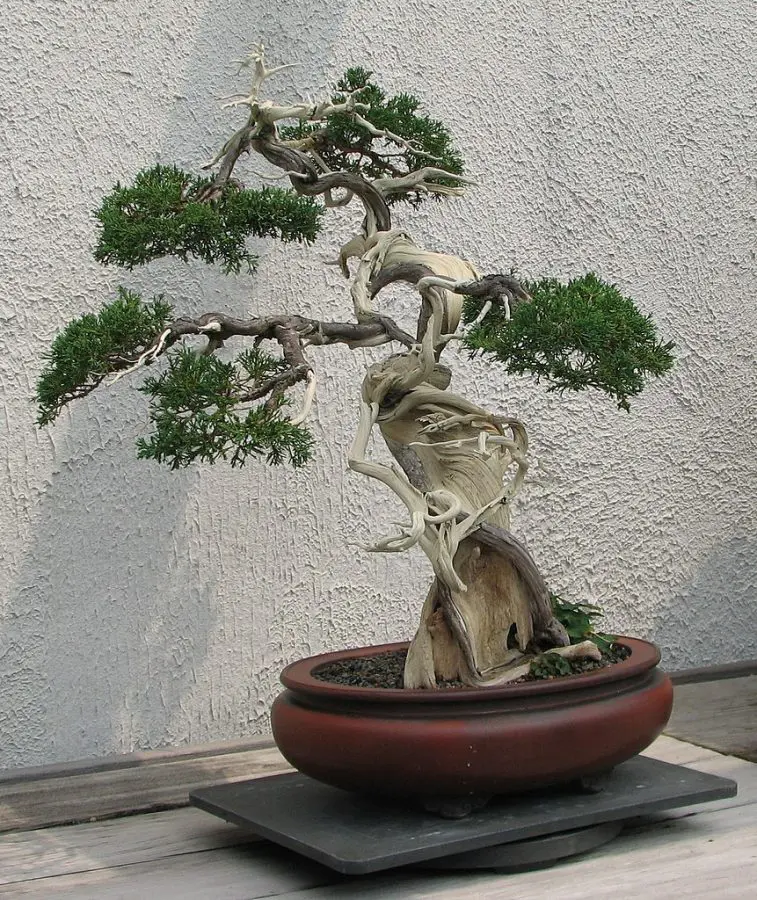
Learn how to care for your indoor juniper bonsai with our expert tips! Keep your bonsai healthy and happy with proper lighting, watering, and more.
Juniper Bonsai Care entails a regimen of proper watering, sunlight, and pruning. Place your bonsai in a spot with ample sunlight, water when the soil appears dry, and maintain its shape with regular pruning. Fertilize monthly during growing seasons, and protect it from extreme temperatures to ensure a thriving miniature tree.
Are you looking to bring a touch of nature into your home? Indoor juniper bonsai can be a perfect addition to your decor.
However, taking care of these tiny trees requires attention and expertise.
In this post, we’ll walk you through the essentials of indoor juniper bonsai care, from lighting and watering to winter care and temperature considerations.
With our expert tips, you’ll be able to keep your bonsai plant healthy and thriving for years to come!
Introduction To Indoor Juniper Bonsai Care
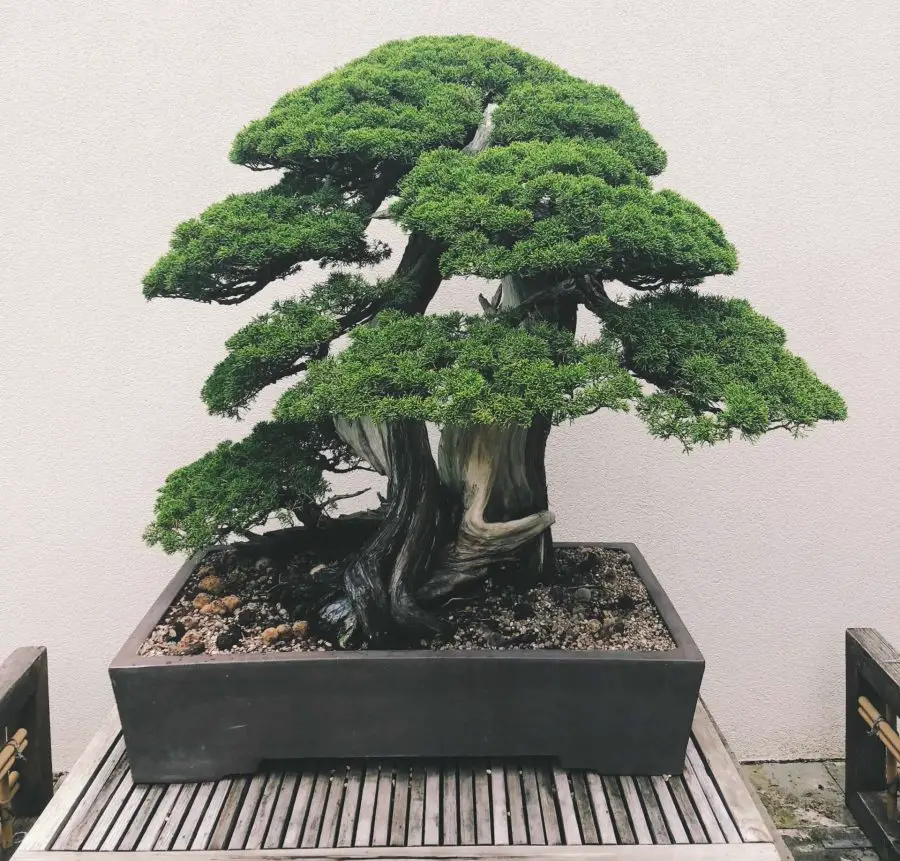
Are you ready to learn some tips and tricks for taking care of your favorite plants?
Whether you’re a seasoned plant parent or a newbie to the world of indoor gardening, we’ve got you covered.
In this post, we’ll be exploring the fascinating world of indoor juniper bonsai care.
From understanding the different types of juniper bonsai to providing the right lighting and watering, we’ll take you through all the basics of taking care of these delicate trees.
So, let’s dive in and get started!
Why is juniper a popular bonsai tree?
Juniper is a popular bonsai tree for several reasons.
First and foremost, juniper trees have a beautiful and distinctive appearance that makes them stand out among other bonsai species.
Their needle-like foliage and twisting branches can be trained into intricate designs that are both striking and unique.
Junipers are also hardy and adaptable, making them a great choice for bonsai enthusiasts of all skill levels.
They are able to tolerate a wide range of growing conditions, from cold winters to dry summers, making them a versatile option for indoor or outdoor cultivation.
Another reason for their popularity is their longevity. With proper care, juniper bonsai trees can live for decades, providing years of enjoyment and beauty.
Their long lifespan also means that they can be passed down through generations, becoming treasured family heirlooms.
Overall, juniper bonsai trees are a favorite among bonsai enthusiasts due to their distinctive appearance, hardiness, and longevity.
What is Indoor Juniper Bonsai Care?
Indoor juniper bonsai care is the art of growing and maintaining small juniper trees indoors.
These miniature trees are carefully shaped and pruned to create unique and beautiful designs.
Juniper bonsai trees require specific care and attention to thrive, including proper lighting, watering, temperature, and soil conditions.
Why Proper Care and Maintenance is Important
Taking proper care of your indoor juniper bonsai is crucial for its health and longevity.
Neglecting your bonsai tree can result in a range of issues, including leaf drop, root rot, and pest infestations.
On the other hand, providing the right care can help your bonsai grow strong and healthy, producing beautiful foliage and intricate branches.
Overview of Topics Covered in this Post
In this post, we’ll cover all the essentials of indoor juniper bonsai care.
We’ll start by discussing the different types of juniper bonsai and their ideal growing conditions.
Next, we’ll dive into lighting requirements, including natural vs. artificial light and recommended conditions.
We’ll also explore watering techniques, including frequency and factors affecting watering needs.
Additionally, we’ll touch on winter care and temperature considerations to keep your bonsai healthy and happy year-round.
Understanding Juniper Bonsai
Juniper bonsai trees are fascinating little plants that can add a touch of natural beauty to any space.
However, before you dive into caring for your own juniper bonsai, it’s important to understand what makes these trees unique.
Junipers are part of the conifer family and are native to many parts of the world.
They are prized for their striking foliage and hardy nature and have been cultivated as bonsai trees for centuries.
In this section, we’ll take a closer look at the different types of juniper bonsai and their ideal growing conditions. So, let’s get started!
Common Juniper Bonsai
Common juniper bonsai, also known as Juniperus communis, is a popular species of juniper for bonsai cultivation.
These trees are known for their blue-green foliage and gnarled, twisting branches.
They are hardy and can tolerate a range of growing conditions, making them a great choice for beginners.
Japanese Juniper Bonsai
Japanese juniper bonsai, or Juniperus procumbens, is another popular species of juniper for bonsai cultivation.
These trees are native to Japan and have a low, sprawling growth habit that makes them ideal for cascading or semi-cascade styles.
They have distinctive needle-like foliage that can range from blue-green to bright green.
Juniper Species
There are quite a few other juniper species that can be used for bonsai.
Some species are more commonly used than others, and the techniques used to care for and shape them may vary slightly depending on the species.
For example, the Japanese garden juniper (Juniperus procumbens) is a popular choice for bonsai due to its small size and interesting bark and foliage.
The Japanese needle juniper (Juniperus rigida) is another common species used for bonsai and is known for its attractive blue-green needles.
The California juniper (Juniperus californica) and Sierra juniper (Juniperus occidentalis) are both native to the Western United States and are known for their rugged, gnarled trunks and branches, which can make for interesting bonsai specimens.
The Chinese juniper (Juniperus chinensis) and green mound juniper (Juniperus procumbens ‘Nana’) are also commonly used for bonsai and are known for their attractive foliage and ability to tolerate a wide range of growing conditions.
The rocky mountain juniper (Juniperus scopulorum) is another species that can be used for bonsai, but it is less commonly seen in the bonsai world.
Green Mound Junipers (Juniperus procumbens ‘Nana’) are a low-growing shrub and spreading evergreen shrub commonly used in landscaping and bonsai cultivation.
They have a dense and compact growth habit, with blue-green foliage that turns bronze in winter.
Green Mound Junipers are very adaptable and can grow in a variety of soil types and light conditions, making them a popular choice for novice bonsai growers.
They are also resistant to many pests and diseases, making them relatively easy to care for.
Characteristics and Growth Habits
Juniper bonsai trees have several unique characteristics that make them stand out from other bonsai species.
They have needle-like foliage that can be either scale-like or awl-like, depending on the species.
Their branches are often twisted and gnarled, giving them a distinctive appearance.
Juniper bonsai trees are also known for their hardy nature and adaptability to a range of growing conditions.
Ideal Environment for Indoor Juniper Bonsai
Indoor juniper bonsai trees thrive in bright, indirect light and require well-draining soil.
They prefer temperatures between 60-75°F (15-24°C), with humidity levels around 50-60%.
It’s important to keep your bonsai away from cold drafts and hot, dry air. With the right conditions, your indoor juniper bonsai can thrive for years to come.
Lighting for Indoor Juniper Bonsai
When it comes to caring for indoor juniper bonsai trees, one of the most important factors to consider is lighting.
Like all plants, juniper bonsai trees require the right amount of light to grow and thrive.
However, getting the right balance of light can be a bit tricky, especially if you’re new to bonsai cultivation.
In this section, we’ll take a closer look at the lighting needs of indoor juniper bonsai trees and provide some tips for ensuring that your tree gets the light it needs to flourish.
So, let’s shed some light on this important topic!
Natural vs. Artificial Lighting
When it comes to lighting your indoor juniper bonsai tree, you have two main options: natural or artificial lighting.
Natural lighting refers to the sunlight that your bonsai tree receives from a window or other opening in your home.
Artificial lighting, on the other hand, refers to the use of grow lights to provide the necessary light for your tree.
Both options have their advantages and disadvantages, so it’s important to choose the one that works best for your specific situation.
Importance of Proper Lighting
Proper lighting is essential for the health and growth of your indoor juniper bonsai tree.
Without enough light, your tree may become weak and stunted, while too much full sunlight can cause the leaves to dry out and become scorched.
It’s important to find the right balance of light to ensure that your bonsai tree thrives.
Recommended Lighting Conditions
Indoor juniper bonsai trees prefer bright indirect light.
If you’re using natural lighting, try placing your tree near a window that receives plenty of light, but isn’t directly in the path of the sun’s rays.
Try hanging sheer curtains in the window to filter the sun’s rays,
If you’re using grow lights, make sure to choose a light that provides the right spectrum of light for your tree, and position it so that your tree receives light from all angles.
Common Lighting Issues and Solutions
One of the most common issues with indoor juniper bonsai trees is not getting enough light.
If your tree isn’t getting enough light, you may notice that the leaves are turning yellow or falling off.
To solve this problem, try moving your tree to a brighter location or investing in a grow light.
On the other hand, if your tree is getting too much light, you may notice that the leaves are becoming dry and brittle.
To solve this problem, try moving your tree to a shadier location or adjusting the position of your grow light.
Watering Indoor Juniper Bonsai
Watering your indoor juniper bonsai tree can be a bit of a balancing act.
Give it too much water, and you risk drowning the roots and causing root rot.
Give it too little water, and your tree may become weak and wither away.
But don’t worry! With a little bit of know-how and attention to detail, you can easily master the art of watering your juniper bonsai tree.
In this section, we’ll dive into everything you need to know about watering your indoor juniper bonsai tree, from how often to water it to the best methods for ensuring that your tree stays hydrated and healthy.
So, let’s dig in!
Watering Techniques
Watering your indoor juniper bonsai tree requires a gentle touch and a careful approach.
Use bonsai soil for your plants and pots with drainage holes. You need good drainage.
If you don’t use well-drained soil you run the risk of root rot. Don’t try to use ordinary potting soil.
One common technique is to water the soil until it starts to drain out of the bottom of the pot.
This helps to ensure that the soil is thoroughly moistened and that any excess water is drained away.
Another technique is to mist the leaves and branches of your tree with a spray bottle, which can help to increase the humidity levels around your tree.
Frequency of Watering
The frequency of watering your indoor juniper bonsai tree depends on a variety of factors, including the size of your tree, the type of soil it’s planted in, and the environmental conditions in your home.
For best results and as a general rule of thumb, you should aim to water your tree when the top layer of the soil surface feels slightly dry to the touch.
It’s important to avoid over-watering, which can lead to root rot, or under-watering, which can cause your tree to wilt and die.
Factors Affecting Watering Needs
Several factors can affect the watering needs of your indoor juniper bonsai tree.
For example, if you keep your tree in a warm, dry environment, it may need to be watered more frequently to prevent it from drying out.
Similarly, if your tree is in a small pot or planted in a soil mix that drains quickly, it may require more frequent watering than a larger tree or a soil mix that retains moisture.
Water Quality and Bonsai Health
The quality of the water you use to water your indoor juniper bonsai tree can also have an impact on its health.
If you live in an area with hard water or high levels of chlorine, it’s a good idea to use distilled water or rainwater to water your tree.
Allow the water to reach room temperature, which is less likely to shock the roots of your tree.
Using distilled or filtered water can also help to improve the health of your bonsai tree over time.
Chlorine, fluorides, and other minerals can accumulate in the soil over time and harm the roots.
The old advice of letting water sit overnight so the chlorine can disperse no longer works because chlorine has been replaced by chloramines which will not evaporate away.
Fertilizing Indoor Juniper Bonsai
Fertilizing is essential for maintaining the health and vigor of indoor juniper bonsai trees.
Bonsai trees are grown in small containers with limited soil nutrients, so regular fertilization is necessary to supply them with the necessary nutrients for growth and development.
Types of fertilizers
There are various types of fertilizers available for bonsai trees, including organic and inorganic options.
Organic fertilizers are derived from natural sources such as bone meal, fish emulsion, and compost.
Inorganic fertilizers, also known as chemical fertilizers, are synthetic and provide a more concentrated source of nutrients.
When to fertilize
The best time to fertilize indoor juniper bonsai trees is during the growing season, which typically lasts from early spring, through the summer months and into the fall season.
Avoid fertilizing during the winter months when the tree is in its dormancy period.
It is also important to follow the instructions on the fertilizer packaging, as over-fertilization can be harmful to the tree.
How to fertilize
Fertilizer can be applied in various ways to indoor bonsai trees, including liquid fertilizer applications, slow-release pellets, and granular forms.
Liquid fertilizers are easiest to use but make sure you use a balanced fertilizer made for bonsai trees that contains all the necessary macro and micronutrients.
It is important to apply the fertilizer evenly and avoid getting it on the foliage or trunk of the tree, as this can cause burning.
Frequency of fertilization
The frequency of fertilization depends on the type of fertilizer used and the growth rate of the tree.
In general, indoor juniper bonsai trees should be fertilized every two to four weeks during the growing season, and less frequently during the winter months.
Fertilizing is an important aspect of indoor juniper bonsai care that should not be overlooked.
By providing the tree with the necessary nutrients, you can ensure its health and longevity.
Remember to follow the instructions on the fertilizer packaging, and monitor the tree’s growth to adjust your fertilization schedule accordingly.
Insect pests for indoor juniper bonsai:
Insect pests can be a common problem for indoor juniper bonsai, but there are ways to prevent and manage infestations.
Some common pests that may affect juniper bonsai include spider mites, scale insects, and mealybugs.
Spider mites are tiny arachnids that can cause the yellowing and dropping of leaves, as well as webbing on the plant.
They thrive in hot, dry conditions, so keeping the bonsai well-hydrated and in a humid environment can help prevent infestations.
If spider mites do appear, spraying the plant with water or using an insecticidal soap can help control the population.
Scale insects are small, immobile insects that attach themselves to the bonsai and feed on its sap.
They can be identified by their shell-like covering, which protects them from predators and insecticides.
One way to remove scale insects is to gently scrape them off the plant with a soft-bristled brush or toothbrush.
Insecticidal soap or neem oil sprays can also be effective in controlling scale infestations.
Mealybugs are white, fuzzy insects that feed on the sap of the bonsai and can cause stunted growth and yellowing leaves.
They are often found in the crevices between branches and leaves.
To control mealybug infestations, it’s important to regularly inspect the bonsai for signs of the insects and to remove them manually with a cotton swab or brush dipped in alcohol.
Insecticidal soap or neem oil sprays can also be used to manage mealybug populations.
Prevention is key when it comes to managing insect pests in indoor juniper bonsai.
Keeping the plant healthy and well-maintained, as well as regularly inspecting it for signs of infestations, can go a long way in preventing insect problems from becoming serious.
If an infestation does occur, however, there are a variety of treatment options available to help manage the problem and protect the health of the bonsai.
Winter Care for Juniper Bonsai
Some people do have outdoor juniper bonsai trees. Winter can be a challenging time for outdoor juniper bonsai trees, as they require special care to survive the cold and dry conditions that can come with the season.
With a little extra attention and some careful planning, however, you can help your tree thrive during the winter months and emerge even stronger come springtime.
In this section, we’ll explore some of the key factors to keep in mind when caring for your indoor juniper bonsai during the winter season.
Winter care for juniper bonsai trees indoors
When caring for an indoor juniper bonsai during the winter months, it’s important to keep a few key factors in mind.
First, you’ll want to make sure that your tree is getting enough light and warmth, as the colder temperatures and shorter days of winter can cause growth to slow down or even come to a halt.
You may need to adjust your tree’s positioning or lighting setup to ensure that it’s getting the right amount of light and heat.
Additionally, you’ll want to be mindful of your tree’s watering needs, as indoor environments can become particularly dry during the winter months.
It’s important to strike a balance between keeping the soil moist enough to support healthy growth and avoiding overwatering, which can lead to root rot or other problems.
Finally, you’ll want to monitor your tree for signs of stress or disease, and take steps to address any issues that arise.
With proper care and attention, your indoor juniper bonsai can thrive even in the coldest months of the year.
Winter dormancy and care requirements:
During the winter months, indoor juniper bonsai trees may enter a period of dormancy, where their growth slows down and they require less water and nutrients.
It’s important to adjust your care routine accordingly during this time, by reducing watering frequency and avoiding fertilization.
Keep an eye on your tree’s foliage and branches for signs of stress or damage, and make any necessary adjustments to your care routine.
Protecting bonsai from cold drafts:
Indoor environments can be prone to drafts, which can cause stress or damage to your juniper bonsai tree during the winter months.
Be sure to keep your tree away from drafty windows, doors, or vents, and consider using a humidity tray or other method to help regulate temperature and moisture levels in your bonsai’s immediate environment.
Maintaining appropriate humidity levels:
Winter air can be dry and dehydrating, which can be especially tough on indoor juniper bonsai trees.
To help maintain appropriate humidity levels, you can consider using a humidifier or a humidity tray filled with water and pebbles.
Be sure to keep an eye on the water level in your tray, and refill it as needed to keep your tree’s environment moist and healthy.
Winter watering techniques and frequency:
As noted earlier, indoor juniper bonsai trees require less water during the winter months, as they may be in a period of dormancy or reduced growth.
Be sure to adjust your watering frequency accordingly, by allowing the soil to dry out slightly between watering sessions.
You can use a moisture meter or your finger to test the soil’s moisture level and water your tree thoroughly when the top inch of the soil feels dry to the touch.
Temperature Considerations
When it comes to indoor juniper bonsai care, the temperature is a critical consideration to keep in mind.
Juniper bonsai trees are hardy and adaptable, but they still have specific temperature needs that must be met to ensure their health and well-being.
In this section, we’ll explore the temperature requirements for indoor juniper bonsai trees, including the ideal temperature range, common temperature-related issues, and tips for maintaining a healthy and stable temperature in your bonsai’s environment.
• The ideal temperature range for indoor juniper bonsai trees is between 60-75°F (15-24°C).
Temperatures outside of this range can cause stress to the tree and affect its growth and overall health.
• Temperature fluctuations can have negative effects on indoor juniper bonsai trees.
Rapid changes in temperature can cause damage to the tree’s buds and needles, and lead to stunted growth or death.
It’s important to maintain a stable temperature in the bonsai’s environment to avoid these issues.
• Protecting your bonsai from extreme temperatures is essential to its survival. If the temperature drops below 50°F (10°C), the tree can become dormant, and it’s important to reduce watering and avoid fertilizing during this time.
In the case of extreme heat, it’s important to provide shade and increase humidity levels to prevent the tree from drying out. Additionally, you can move the tree to a more suitable location to protect it from extreme temperatures.
Juniper Bonsai Care FAQs
Cultivating a Juniper Bonsai is akin to having a slice of ancient, natural art right within your dwelling.
These miniature trees embody grace and tranquility, and with the right care, they can thrive indoors for many years.
Their care routine is a blend of art and horticulture, embodying a tradition that goes back centuries. Below are some common queries regarding the nurturing of Juniper Bonsai:
Q. What is the ideal location for a Juniper Bonsai?
A. Juniper Bonsai prefers outdoor settings with ample sunlight. However, if indoors, place them near a window where they can receive at least 4-6 hours of sunlight daily.
Q. How often should I water my Juniper Bonsai?
A. Watering should be done when the top of the soil feels dry to the touch. Over-watering can lead to root rot, so it’s crucial to let the soil dry out between watering sessions.
Q. What type of soil is best for Juniper Bonsai?
A. Well-draining soil is vital. A mix of akadama, pumice, and lava rock in equal parts is often recommended for Juniper Bonsai to ensure proper drainage and nutrient retention.
Q. How should I go about pruning and shaping my Juniper Bonsai?
A. Regular pruning is essential to maintain its shape and promote dense foliage growth. Use sharp scissors to prune and wiring techniques to shape your bonsai, ensuring it reflects the aesthetic you desire.
Indoor Juniper Bonsai Care Conclusion
Congratulations on making it through our guide to indoor juniper bonsai care!
We hope that you’ve gained valuable insights and tips into the art of bonsai and for taking care of your bonsai tree and ensuring its long-term health and growth.
Recap
Remember, proper care and maintenance are essential for a thriving bonsai, and with patience and diligence, you can enjoy the beauty of your indoor juniper bonsai for years to come.
In summary, we’ve covered a range of tips and techniques for indoor juniper bonsai care, from lighting and watering to winter care and temperature considerations.
Remember to provide proper lighting and watering conditions, protect your bonsai from extreme temperatures, and maintain appropriate humidity levels.
It’s important to note that regular maintenance and monitoring are crucial for a healthy and thriving bonsai or just about any indoor plants.
Keep an eye on your tree’s growth and appearance, and adjust your care routine as needed.
Buy your Juniperus procumbens – Nana plant here
Enjoy Indoor Juniper Bonsai Care!
Finally, growing an indoor juniper bonsai can be a rewarding and fulfilling experience.
With patience, dedication, and a little bit of knowledge, you can create a beautiful and unique addition to your home or office.
Don’t be afraid to experiment and try new techniques, and always remember to enjoy the journey of growing and caring for your bonsai.











